|
Steering and Sail Trim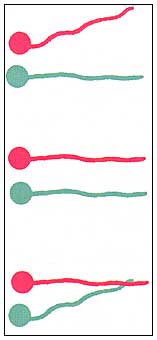
By David Dellenbaugh
Steering
Steer by the middle telltales.
When you are steering by the telltales on the luff
of the jib, try to use the ones that are about
halfway up the sail. These might be a bit harder to
see (compared to telltales that are lower), but they
will give you a more accurate reading for the whole
sail than telltales closer to the top or bottom of
the sail. Move foreword and outboard to see the
middle telltales more clearly.
Move left, turn right.
Before moving your tiller or wheel to turn the boat,
use weight placement to steer by changing the boat’s
heel angle. If you want to turn left, move your
weight to the right so you heel the boat to
starboard. When you want to turn right, move left.
This works best in lighter air and with smaller
boats, but it will help to some extent in all boats
and in any condition.
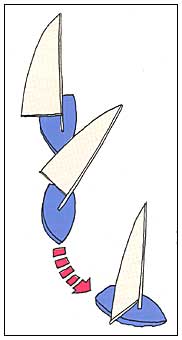 Minimize helm downwind. Minimize helm downwind.
When sailing upwind, it’s good to have a bit of
windward helm to give the rudder more feel and lift.
But on a run or reach an off-center rudder just
creates drag, and this is slow. Therefore, adjust
the trim of your boat and sails to keep your rudder
centered and your helm neutral as much as possible.
The boat should almost steer itself in a straight
line.
Steer under your sails.
When you’re running in windy and/or wavy conditions,
the best way to stay in control and going fast is to
steer your boat under the rig and sails. If your
boat heels to leeward, bear off to get the hull
under your mast. If your boat heels to windward,
head up. The idea is to keep your mast roughly
vertical by steering your boat so the bottom of the
mast stays under the top. It’s like trying to
balance a long stick vertically with one end in the
palm of your hand. If you have a symmetrical
spinnaker, an easy guide is to aim your bow at the
center of the sail’s foot (where there is often a
vertical seem).
Always use sails for turning.
Turning the rudder always makes you slower,
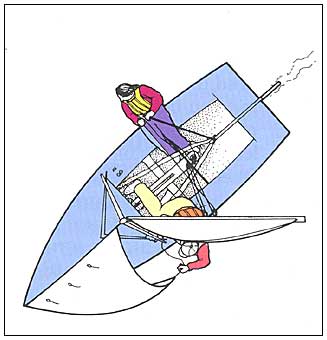 so any
time you want to turn your boat you should use sail
trim to help as much as possible. When you wish to
head up, trim your mainsail tighter (and ease the
jib a little); when you want to bear off, ease your
mainsheet (and trim your jib). This is especially
important in heavy air when turning the rudder and
moving crew weight from side to side are less
effective methods of turning. If you’ve ever tried
to bear off behind a starboard tacker without easing
the mainsheet you know that sail trim has a huge
impact on where the boat goes. so any
time you want to turn your boat you should use sail
trim to help as much as possible. When you wish to
head up, trim your mainsail tighter (and ease the
jib a little); when you want to bear off, ease your
mainsheet (and trim your jib). This is especially
important in heavy air when turning the rudder and
moving crew weight from side to side are less
effective methods of turning. If you’ve ever tried
to bear off behind a starboard tacker without easing
the mainsheet you know that sail trim has a huge
impact on where the boat goes.
Try using a ‘wider groove.’
When sailing upwind, it’s hard to keep your boat in
the groove all the time. As soon as conditions
change (e.g. you hit a wave or lull), most sailors
lose their groove at least for a little while.
That’s why it’s often good to set up the boat so it
has a wide groove, especially in tough conditions
like shifty wind and chop. Ways to do this include
twisting the sails, easing sheets slightly, making
sails fuller, moving draft forward (especially in
the headsail), heeling a little more, footing
slightly and so on. This will make the boat more
forgiving and easier to steer fast.
Don’t always swing wide.
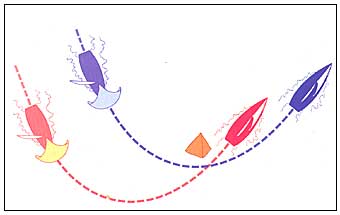 Conventional wisdom says you should round a mark by
swinging wide on the near side and close on the far
side (like the red boat below). However, this is not
the fastest way to get around the mark. Unless you
are worried about your position relative to other
boats, it’s better to approach the mark closer on
the near side, pass it on a beam reach, and end up
farther from the mark as you turn up closehauled
(like the blue boat). The key is making your turn so
the mark is at the bottom of your arc; if you don’t
do this you will sail extra distance. Of course,
there may be tactical reasons (e.g. boats just ahead
or behind) why it makes sense to round wide and
tight so you are on a closehauled course when you
pass the mark. Conventional wisdom says you should round a mark by
swinging wide on the near side and close on the far
side (like the red boat below). However, this is not
the fastest way to get around the mark. Unless you
are worried about your position relative to other
boats, it’s better to approach the mark closer on
the near side, pass it on a beam reach, and end up
farther from the mark as you turn up closehauled
(like the blue boat). The key is making your turn so
the mark is at the bottom of your arc; if you don’t
do this you will sail extra distance. Of course,
there may be tactical reasons (e.g. boats just ahead
or behind) why it makes sense to round wide and
tight so you are on a closehauled course when you
pass the mark.
Sail Trim
Set up for the lulls.
When the wind is puffy, it’s impossible to set your
sails correctly for all different velocities you
will see. If your sails are too full, you’ll be too
slow in the puffs, but if they’re too flat then you
will struggle in the lulls. The best choice is
usually to err on the side of tuning for the lulls.
That’s because it is relatively easy to go fast in
puffs, and you can live with being overpowered
temporarily. But in the lulls you need lots of power
if you don’t have it you will struggle to keep up
with your competition.
Top batten parallel.
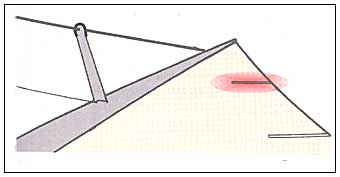 Getting the right main trim is critical for good
speed in any condition. If you overtrim the main, it
will stall and be slow. If you undertrim the main,
you’ll be faster but you won’t be able to point. The
key is finding a happy medium that works for both
speed and pointing. The easiest guideline is
trimming the sheet so the top batten is parallel
with the boom. In light air and lump, let the top
batten angle off to leeward a bit. In flat water and
more wind, trim the sheet hard enough so the top
batten angles to windward. Getting the right main trim is critical for good
speed in any condition. If you overtrim the main, it
will stall and be slow. If you undertrim the main,
you’ll be faster but you won’t be able to point. The
key is finding a happy medium that works for both
speed and pointing. The easiest guideline is
trimming the sheet so the top batten is parallel
with the boom. In light air and lump, let the top
batten angle off to leeward a bit. In flat water and
more wind, trim the sheet hard enough so the top
batten angles to windward.
Don’t cleat the sheet!
The wind is always changing so if you want to go
fast you must constantly adjust the trim of your
boat and sails. Therefore (if possible) don’t cleat
your mainsheet! This line is also the best way to
feel your boat’s pulse. Cleating it would be like
turning on cruise control in a car race. Of course,
when it’s windy the helmsperson may need help
holding the sheet, or you may have to put it around
a winch. Just try not to use a cleat.
Trim with a curl.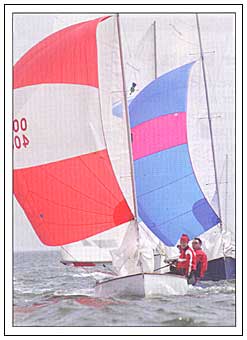
When flying a spinnaker (either asymmetric or
symmetrical), it’s slow to overtrim the sheet. To
make sure the chute rotates foreword as far as
possible, keep easing your sheet until you see a
slight along the luff of the spinnaker. Though this
means you give up a small amount of sail area, it’s
usually much faster to have the sail eased all the
way with a small curl than to get rid of the curl
but risk having the sail overtrimmed some of the
time.
When you’re going fast trim harder.
When your boat feels good (like it’s going fast
through the water), trim the main a little harder
and point the bow slightly higher. If the boat feels
bad or starts to slow down, ease the mainsheet a bit
and bear off. Once you are going fast again, start
trimming again. This is a never-ending cycle. Try to
keep trimming the mainsheet harder to help pointing,
but when this makes you go slower ease the sheet for
speed.
Judge trim by speed, not by looks.
When trimming your sails, the goal is to make your
boat go as fast as possible. It’s nice when the
sails look beautiful too, but this is not your
objective. The key is to trim for performance, not
appearance. The way the sails look is just a guide
that may help you go fast. So don’t be too rigid
about what you’re looking for. Sail shape is a means
to an end - what really matters is how well you
perform relative to other boats.
Go fast at the start.
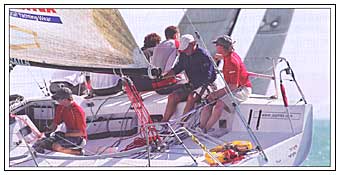 When do you expect the wind velocity to change after
the start, how should you set up your sails? Your
number one priority should be to optimize your sail
trim for the wind you will have during the first few
minutes after the start. When you come off the line,
you want your boat to be as fast as possible so you
can pop out ahead of the pack. If the wind does
change later in the leg or race, it’s much better to
be leading the fleet with a wrong set-up than back
in the pack with a perfect sail trim. When do you expect the wind velocity to change after
the start, how should you set up your sails? Your
number one priority should be to optimize your sail
trim for the wind you will have during the first few
minutes after the start. When you come off the line,
you want your boat to be as fast as possible so you
can pop out ahead of the pack. If the wind does
change later in the leg or race, it’s much better to
be leading the fleet with a wrong set-up than back
in the pack with a perfect sail trim.
Dave publishes the newsletter Speed & Smarts. For a
subscription call: 800-356-2200 or go to:
www.speedandsmarts.com
TOP
|